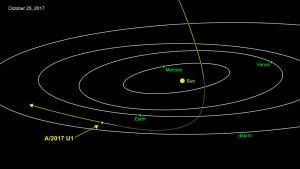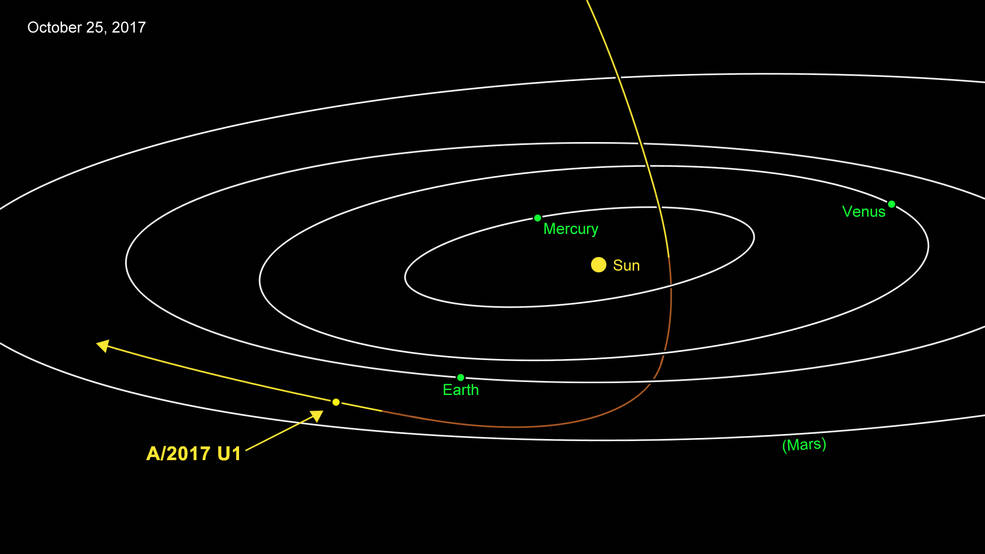Nasa view intense solar activity from space
A small asteroid or comet that has been spotted racing through our solar system may have come from elsewhere in the galaxy
, US space scientists say, possibly marking the first such interstellar visitor observed from Earth.
The mystery object, so far known only as A/2017 U1, was discovered earlier this month by a researcher using a
sophisticated telescope system at the University of Hawaii that continually scans the universe for such phenomenon.
“We have been waiting for this day for decades,” said Paul Chodas, manager of the National Aeronautics and Space
Administration’s Center for Near Earth Object Studies at the Jet Propulsion Laboratory in Pasadena, California.
Astronomers were stunned to see the first known object flung through our cosmic neighborhood from interstellar space.
That is, until the University of Hawaii’s Pan-STARRS 1 telescope last week discovered what appears to be the first ever seen “interstellar object” — an asteroid (or maybe a comet) that escaped from the gravitational grasp of another star and fell through the roof of our solar system.
That makes the object currently designated A/2017 U1 an alien of sorts around our corner of the cosmos.
The foreign space-something is less than a quarter-mile (400 meters) across, but is moving super fast at 15.8 miles
(25.5 kilometers) per second. That’s over three times faster than Asteroid 2012 TC4, the rock that gave Earth a close
shave earlier this month.
A/2017 U1 dropped into our neighborhood from “above” the relatively flat ecliptic plane in space
where the planets and other asteroids orbit the sun. So, if you imagine our solar system as being more or
less flat, it’s as if the object dropped in out of the sky. But rather than impacting anything in our solar system,
the object passed closer to the sun than the orbit of Mercury on Sept. 2 before making a hairpin turn under
our solar system and getting flung back out of town.
 Weryk immediately realized this was an unusual object. “Its motion could not be explained using either a normal
solar system asteroid or comet orbit,” he said. Weryk contacted IfA graduate Marco Micheli,
who had the same realization using his own follow-up images taken at the European Space Agency’s
telescope on Tenerife in the Canary Islands. But with the combined data, everything made sense. Said Weryk, “This object came from outside our solar system.”
“This is the most extreme orbit I have ever seen,” said Davide Farnocchia, a scientist at NASA’s Center for
Near-Earth Object Studies (CNEOS) at the agency’s Jet Propulsion Laboratory in Pasadena, California. “It is going
extremely fast and on such a trajectory that we can say with confidence that this object is on its way out of
the solar system and not coming back.”]]>
Weryk immediately realized this was an unusual object. “Its motion could not be explained using either a normal
solar system asteroid or comet orbit,” he said. Weryk contacted IfA graduate Marco Micheli,
who had the same realization using his own follow-up images taken at the European Space Agency’s
telescope on Tenerife in the Canary Islands. But with the combined data, everything made sense. Said Weryk, “This object came from outside our solar system.”
“This is the most extreme orbit I have ever seen,” said Davide Farnocchia, a scientist at NASA’s Center for
Near-Earth Object Studies (CNEOS) at the agency’s Jet Propulsion Laboratory in Pasadena, California. “It is going
extremely fast and on such a trajectory that we can say with confidence that this object is on its way out of
the solar system and not coming back.”]]>
 <![CDATA[]]>
<![CDATA[]]>